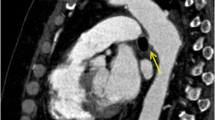Abstract
Objective
To assess the sensitivity and specificity of computed tomography (CT) in the diagnosis of aortoenteric fistula (AEF) and to determine the most accurate CT signs of the disease.
Methods
Hospital records were reviewed over a 20-year period. Twenty-three patients in whom a final diagnosis of AEF was made at laparotomy or autopsy were identified. Ten of these had CT performed. Twelve control cases were also collected. The 22 cases, (10 cases of AEF and 12 controls), were reviewed retrospectively by two independent readers, who were blinded to the clinical features and outcome. Each case was examined for six specific radiological findings. The outcome of other adopted investigative modalities was also examined.
Results
The presence of peri-aortic ectopic gas (>2 weeks following surgery) in the context of gastrointestinal (GI) blood loss was 100% specific for AEF. If AEF was considered to be present where signs of peri-aortic infection were present in a patient with GI bleeding, CT had an overall specificity of 100% (95% confidence interval = 1.0–1.0) and sensitivity of 50%.
Conclusion
CT can rule in the diagnosis of AEF but cannot rule it out. CT is recommended as the first-line investigation in a stable patient with suspected AEF.







Similar content being viewed by others
References
Voorhoeve R, Moll FL, de Letter JA, et al. (1996) Primary aortoenteric fistula: report of eight new cases and review of the literature. Ann Vasc Surg 10:40–48
Reilly LM, Altman H, Lusby RJ, et al. (1984) Late results following surgical management of vascular graft infection. J Vasc Surg 1(1):36–44
O’Hara PJ, Hertzer NR, Beven EG, et al. (1986) Surgical management of infected abdominal aortic grafts: review of a 25-year experience. J Vasc Surg 3(5):725–731
Mark AS, Moss AA, McCarthy S, et al. (1985) CT of aortoenteric fistulas. Invest Radiol 20(3):272–275
Low RN, Wall SD, Jeffrey RB Jr, et al. (1990) Aortoenteric fistula and perigraft infection: evaluation with CT. Radiology 175(1):157–162
Orton DF, LeVeen RF, Saigh JA, et al. (2000) Aortic prosthetic graft infections: radiologic manifestations and implications for management. Radiographics 20(4):977–993
Higgins RS, Steed DL, Zajko AB, et al. (1991) Computed tomographic scan confirmation of paraprosthetic enteric fistula. Am J Surg 162(1):36–38
Raptopoulos V, Cummings T, Smith E (1987) Computed tomography of life-threatening complications of abdominal aortic aneurysm. The disrupted aortic wall. Invest Radiol 22(5):372–376
Maceneaney PM, Malone DE (2000) The meaning of diagnostic test results: a spreadsheet for swift data analysis. Clin Radiol 55(3):227–235
Flye MW, Thompson WM (1983) Aortic graft-enteric and para prosthetic-enteric fistulas. Am J Surg 146:183–187
Bunt TJ (1983) Synthetic vascular graft infection II. Graft enteric erosions and graft enteric fistulas. Surgery 94(suppl I):1–9
Kleinman LH, Towne JB, Bernard VM (1979) A diagnostic and therapeutic approach to aortoenteric fistulas: clinical experience with twenty patients. Surgery 86(6):868–880
Auffermann W, Olofsson P, Stoney R, et al. (1987) MR imaging of complications of aortic surgery. J Comput Assist Tomogr 11(6):982–989
Reilly DT, Grigg MJ, Cunningham DA, et al. (1989) Vascular graft infection: the role of indium scanning. J Vasc Surg 3(5):393–397
Krupnick AS, Lombardi JV, Engels FH, et al. (2003) 18-fluorodeoxyglucose positron emission tomography as a novel imaging tool for the diagnosis of aortoenteric fistula and aortic graft infection—a case report. J Vasc Endovasc Surg 37(5):363–366
Perks FJ, Gillespie I, Patel D (2004) Multidetector computed tomography imaging of aortoenteric fistula. J Comput Assist Tomogr 28(3):343–347
Kayani I, Groves AM, Syed R (2005) Aortoenteric fistula as shown by multidetector computed tomography. Heart 91(3):304
Pierce RM, Jenkins RH, Maceneaney P (2005) Para prosthetic extravasations of enteric contrast: a rare and direct sign of secondary aortoenteric fistula. Am J Roentgenol 184(3 suppl):S73–S74
Author information
Authors and Affiliations
Corresponding author
Rights and permissions
About this article
Cite this article
Hughes, F.M., Kavanagh, D., Barry, M. et al. Aortoenteric fistula: a diagnostic dilemma. Abdom Imaging 32, 398–402 (2007). https://doi.org/10.1007/s00261-006-9062-7
Received:
Accepted:
Published:
Issue Date:
DOI: https://doi.org/10.1007/s00261-006-9062-7




